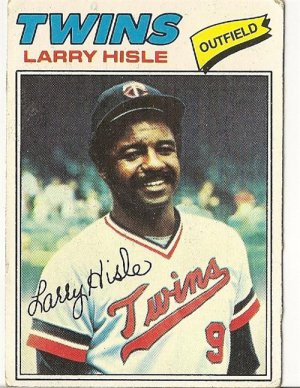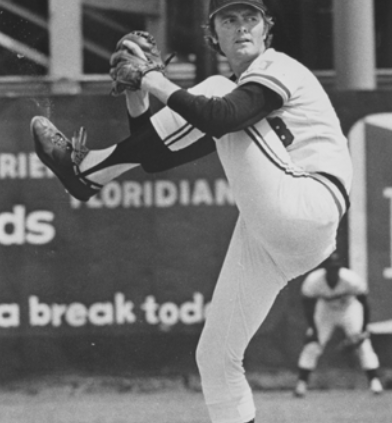July 4, 1974: Hisle homer helps Blyleven overcome Rangers on Independence Day
 An Independence Day crowd of 21,008, the largest gathering of the season at Metropolitan Stadium to that point, came to see the Twins’ 23-year-old pitching ace, Bert Blyleven, take on the Texas Rangers in the finale of a four-game series. Blyleven had been battling a back injury and hard luck for much of the season. After winning 20 games the previous year, he had lost 10 of his first 16 decisions in 1974, including two tough 1-0 contests. As part of an effort to turn around his fortunes, he had enrolled in a course that was “supposed to teach [him] to relax and enjoy [his] work more.”1 Blyleven apparently was a quick learner: He turned in a one-hit performance on Independence Day, “although it did test his patience to the limit” since he had to wait until there were two outs in the bottom of the ninth to see his pitching gem result in victory.2
An Independence Day crowd of 21,008, the largest gathering of the season at Metropolitan Stadium to that point, came to see the Twins’ 23-year-old pitching ace, Bert Blyleven, take on the Texas Rangers in the finale of a four-game series. Blyleven had been battling a back injury and hard luck for much of the season. After winning 20 games the previous year, he had lost 10 of his first 16 decisions in 1974, including two tough 1-0 contests. As part of an effort to turn around his fortunes, he had enrolled in a course that was “supposed to teach [him] to relax and enjoy [his] work more.”1 Blyleven apparently was a quick learner: He turned in a one-hit performance on Independence Day, “although it did test his patience to the limit” since he had to wait until there were two outs in the bottom of the ninth to see his pitching gem result in victory.2
Both Blyleven and the Rangers’ Jim Bibby came out gunning. Each hurler retired the first seven batters he faced, with Blyleven recording four strikeouts and Bibby three. The first hit in the game was Texas shortstop Toby Harrah’s one-out solo homer to right field in the top of the third inning. Although Twins center fielder Steve Brye said that Harrah’s ball “hit the post on the top of the fence and barely bounced out of the park,” the result was still a 1-0 Texas lead.3
Harrah’s homer was his 12th of the season, only one fewer than the 13 he had accumulated over the previous three campaigns. Harrah’s newfound power stroke had made him a thorn in the Twins’ side all season. He had hit exactly half of his homers against Minnesota and already had victimized Blyleven with two round-trippers on June 24, although the Twins had prevailed, 8-4, in that game in Arlington, Texas. After the July 4 game, Blyleven confessed, “Catcher Phil Roofhad called for a curve and I shook him off and threw the fast ball that Harrah hit out.”4 For most of the evening, it looked as though that lone mistake would result in Blyleven’s third 1-0 loss of the season.
Bibby gave up his first hit in the bottom of the third – a single by Roof – but that was all the Twins could muster, and the two big right-handers continued to stifle the opposing lineups. After Harrah’s homer, Blyleven retired nine consecutive Rangers before he allowed the second Texas baserunner of the game via a one-out walk to catcher Jim Sundberg in the sixth. However, that was to be all the base traffic for Texas until the eighth inning.
Bibby allowed two-out doubles in the sixth and seventh innings, but escaped unscathed on both occasions. In the sixth inning, designated hitter Tony Oliva became the first Twins batter to reach second base when, according to a Texas news article, he “was given a double by the charitable home town official scorer.”5 Left fielder Alex Johnson had caught up to Oliva’s fly ball at the warning track, “but it glanced off his glove and the scorer called it a hit instead of an error.”6 It mattered not, as the next batter, Bobby Darwin, flied out to right field.
In the bottom of the seventh inning, Larry Hisle hit a no-doubt double to left-center field after Steve Braun and Jim Holthad been retired. This time around, Minnesota manager Frank Quilici sent Harmon Killebrew to the plate to pinch-hit for Roof. “Killer” quickly flied out to right field on Bibby’s first pitch to him to quash the Twins’ hope for a tie or the lead.
Although Blyleven allowed Texas no further hits, he put himself in a jam via walks in the top of the eighth. Jim Spencer, leading off, drew the second walk issued by Blyleven in the game. Lenny Randle’s sacrifice advanced Spencer to second, and then Blyleven walked Harrah to put two runners on with one out. Blyleven bore down and induced successive fielder’s-choice grounders by Sundberg and César Tovar to keep the score 1-0.
After Bibby set the Twins down in order, Blyleven again put himself in a “two-on and one-out” jam in the top of the ninth. With one out, he hit Johnson with a pitch and then walked right fielder Jeff Burroughs, the eventual 1974 American League Most Valuable Player. Blyleven extricated himself from this mess of his own making by getting Mike Hargrove to ground into a 4-6-3 double play. Now it would be up to the Twins batters to bail out Blyleven.
A new hope arose in the Twins and their fans when Bibby walked the leadoff batter, Oliva. Jerry Terrell ran for Oliva. Although it was only the second walk Bibby had issued, to go along with a mere four Twins hits, Texas skipper Billy Martin pulled his starter and inserted relief ace Steve Foucault. The move looked like another of Martin’s shrewd decisions when Foucault struck out the first batter he faced, Darwin.
Suddenly, however, Martin’s move backfired. Braun singled to right field, and Terrell stopped at third base. Holt lofted a sacrifice fly to Tovar in left field that drove in Terrell to tie the game. Tovar made an ill-advised late throw to home on the play that allowed Braun to take second base. Hisle now stepped up to the plate and sent Foucault’s first offering, a curveball, over the left-field fence for a 3-1 Twins triumph that started the Fourth of July fireworks early in Minneapolis.
Hisle said of his game-winning blast, “I figured that he’d throw me a curve ball, and I was geared for it. … I never hit Foucault much last year, but I’ve done better against him this year. I hit one off him in Texas with two on during our last trip. Yup, a curve ball.”7
There was irony in Hisle having become the hero of the game, a fact that was not lost on the man of the hour himself. Hisle conceded, “I’m sure that if Eric Soderholm would not have had an injured foot I wouldn’t have been in the lineup. I’ve not been swinging the bat very good of late and I can’t blame Frank Quilici for not playing me.”8 On this night, Hisle was 2-for-3 with a double, a homer, and a walk, and two runs batted in. By season’s end, he had appeared in 143 games and had batted .286 with 19 home runs and 79 RBIs.
As for Blyleven, whose mound acumen had kept the Twins in the game, he also claimed to have known what was coming, just as Hisle did in his at-bat. Blyleven asserted, “I told Eric Soderholm in the dugout about the fourth inning that we’d win 2-1 in the ninth inning, but Hisle’s home run made me a one-run liar.”9
Whether or not Blyleven was clairvoyant, he pointed out the reasons for his renewed success on this day. He explained, “I was more relaxed on the mound than I have been lately. I think the self-motivation course I’ve been taking is helping me. … It also was my first game in quite a while that I haven’t had to wear a brace on my back. I hurt my back earlier in the year, but it feels good now.”10 It felt so good that Blyleven overcame his 6-10 start to the season and finished at 17-17. While a .500 pitching record may not seem impressive, it was not an accurate reflection of Blyleven’s stellar 2.66 earned-run average over 281 innings pitched. Instead, as was often the case during Blyleven’s Hall of Fame career, it was more reflective of the fact that he played on an average team; in this instance, it was the 1974 Minnesota Twins, a squad that finished with an 82-80 record.
Notes
1 Fred McMane, “‘Self-Motivation Class’ Pays Off for Blyleven,” St. Cloud (Minnesota) Times, July 5, 1974: 21.
2 McMane.
3 Sid Hartman, “Big Hit for Hisle,” Minneapolis Star Tribune, July 5, 1974: 2C.
4 Hartman.
5 Harold McKinney, “Twins Stun Foucault with Late Home Run,” Fort Worth Star-Telegram, July 5, 1974: 31, 35.
6 McKinney.
7 Tom Briere, “Twins Win 1-Hitter,” Minneapolis Tribune, July 5, 1974: 2C.
8 Hartman.
9 Briere: 1C.
10 McMane.
Additional Stats
Minnesota Twins 3
Texas Rangers 1
Metropolitan Stadium
Bloomington, MN
Box Score + PBP:
Corrections? Additions?
If you can help us improve this game story, contact us.


